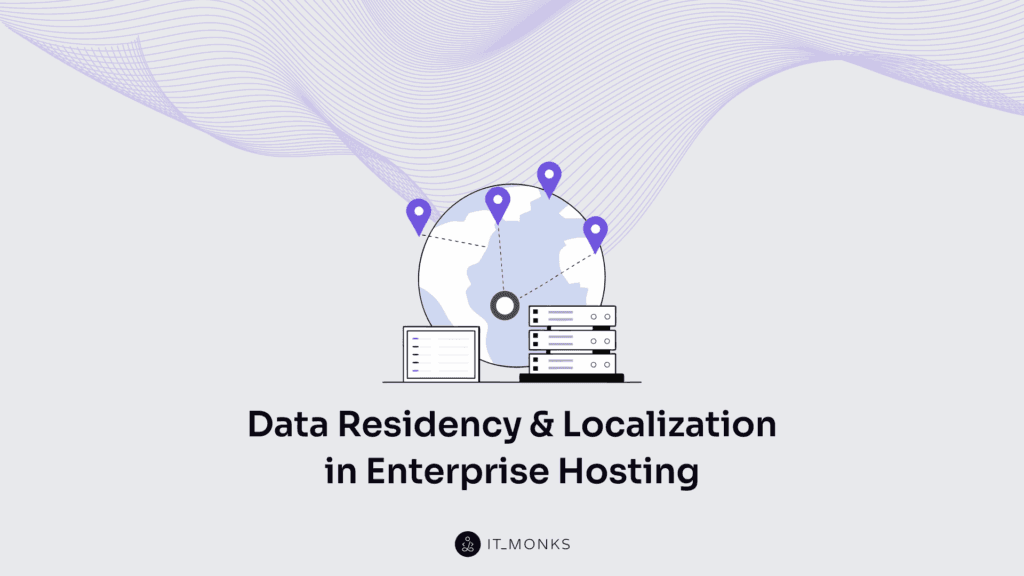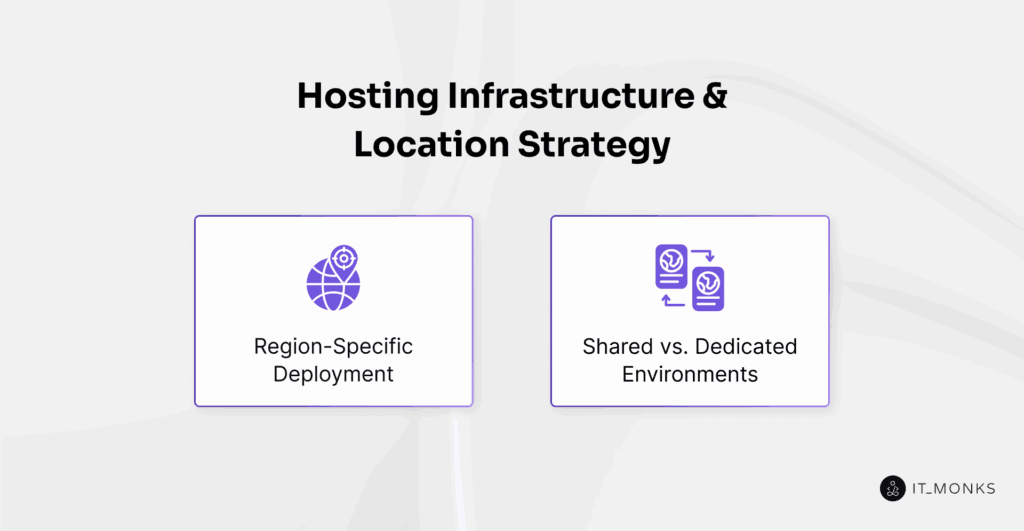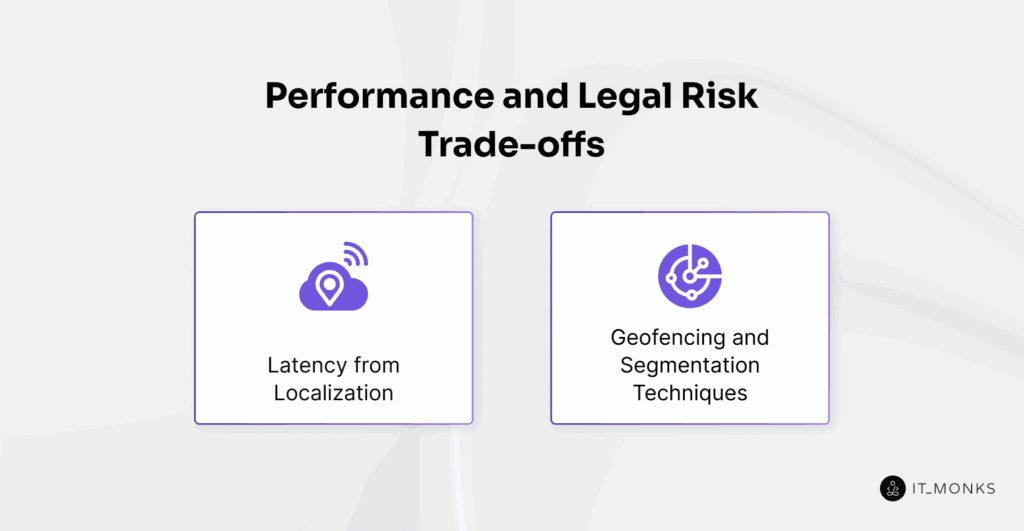Data Residency and Localization in Enterprise Hosting
Table of Contents

Data residency governs where enterprise website data must be stored and processed, within jurisdictionally mandated geographic boundaries. Localization policies extend this control by prohibiting cross-border replication, requiring in-country processing, and mandating the use of domestic infrastructure. These are regulatory mandates that define how hosting infrastructure must operate.
Enterprise websites function across regions with distinct sovereignty enforcement, requiring infrastructure to align with jurisdiction-specific data governance. Residency obligations dictate how storage, replication, and access mechanisms are deployed. Misalignment triggers legal exposure, operational disruption, and compliance penalties.
Each residency rule maps to a geographic storage constraint, enforced through a localization mandate that dictates data movement and replication boundaries. Hosting architectures must implement region-bound deployments and enforce jurisdictional barriers at the system level. Backup, restore, and access routines should remain confined within sovereign legal perimeters.
Cross-border transfers, including internal flows, are treated as regulated events. Compliance frameworks impose contractual restrictions and geofencing to contain data within approved territories. Legal alignment introduces performance trade-offs, including latency and a segmented architecture.
Geographic and Jurisdictional Data Constraints
Geographic and jurisdictional data constraints govern the legal sovereignty perimeter within which an enterprise hosting can replicate and process information. A geographic constraint restricts hosting infrastructure to political borders, binding all enterprise website content to facilities within the country.
This creates a state-bound storage compliance requirement that prevents replication beyond the designated border. A jurisdictional constraint asserts legal reach over the same content even when infrastructure resides abroad, enforcing cross-border legal reach that overrides geographic placement.
A data residency mandate enforces an enclave-based storage model by prohibiting replication outside national borders. When sovereignty enforcement requires data generated in a state to remain inside its legal perimeter, hosting infrastructure must be confined to region-specific deployment zones. Any cross-border transfer constitutes a breach of residency law.
Multiregion enterprise hosting complicates these constraints further, as it involves duplicating environments across legal boundaries. The configuration must respect overlapping data control regimes without triggering sovereignty violations.
A government access policy binds enterprise website content to subpoena scope enforcement regardless of location. For example, the U.S. CLOUD Act permits seizure of data from U.S.-controlled providers even if hosted abroad. This extraterritorial claim creates overlapping jurisdictional control, where multiple states assert sovereignty over the same dataset.
Conflicting obligations expose enterprise websites to multi-jurisdictional conflict exposure. Hosting in one nation’s compliance zone may simultaneously violate another’s protection regime. Surveillance mandates and cross-border subpoenas prevent uniform replication strategies, leaving enterprise websites structurally constrained by incompatible laws.
Hosting infrastructure must therefore align with a legal sovereignty perimeter that dictates replication, backup, and recovery. Region-confined deployments isolate environments subject to different subpoena rights, while replication policies filter out prohibited transfers.
Every infrastructure placement is restricted, permitted, or prohibited by a binding legal authority, which asserts control over both physical storage and logical accessibility.
Enterprise websites must operate on a jurisdiction-aware architecture where each residency zone maps to enforceable state control. Alignment with a constraint matrix determines which providers, regions, and replication paths are legally sustainable, and which combinations are prohibited. Legal authority overrides technical preference; failover locations are chosen by sovereignty enforcement, not efficiency.
Hosting Within National Borders
National hosting mandates restrict enterprise website infrastructure to operate strictly within a country’s borders as a legal and architectural requirement. Laws such as Russia’s Federal Law No. 242-FZ, China’s Cybersecurity Law, and India’s data localization rules enforce domestic processing, storage, and transit of data. These constraints apply to every infrastructural component, from replication paths to service deployment.
Regulated industries, including government, healthcare, finance, and telecom, are confined to sovereign hosting environments. Enterprise websites in these sectors cannot legally use foreign-owned cloud providers or those without in-country data centers. Providers without sovereign-compliant infrastructure are disqualified by default.
Disaster recovery and replication architectures must remain fully domestic; cross-border failover, global CDNs, and foreign backups breach residency obligations. Encryption never substitutes for jurisdiction; compliance is defined by the location of the data, while access controls are secondary. Even partial or sharded datasets remain jurisdiction-bound under enforcement laws.
Cloud models are constrained by legal geography. Foreign providers are excluded if they lack jurisdictional alignment, regardless of security protocols. Only those with in-country infrastructure and a legal presence meet compliance requirements.
Non-compliance results in penalties, including service blocks, fines, and regulatory action. Compliance is enforced through infrastructure design, not policy. For enterprise websites, national hosting mandates convert geographic location into a legal system boundary; every node, route, and replica must exist within the domestic perimeter.
Government Access and Legal Conflicts
Government access mandates, such as the U.S. CLOUD Act, override geographic controls on enterprise website data. The CLOUD Act compels U.S.-based providers to disclose customer data, regardless of storage location.
In contrast, GDPR prohibits such transfers without explicit user consent, even under a valid foreign subpoena. These laws directly conflict when enterprise websites are hosted on infrastructure spanning multiple jurisdictions.
A U.S.-controlled provider storing EU-based data may face a U.S. legal order to disclose it under the CLOUD Act. GDPR Article 48 requires disclosure to be based on an international agreement, making unilateral compliance unlawful. While the CLOUD Act provides a comity mechanism to resolve conflicting obligations, enterprises still face a jurisdictional conflict in which compliance with one regime risks violating the other. This persistent tension embeds a compliance contradiction into enterprise architecture.
Disaster recovery systems extend the risk; subpoena powers apply to logs, backups, and replicas, even if they are encrypted or regionally isolated. Legal mandates override technical safeguards and reach into every recovery layer.
For example, an EU-hosted website using U.S.-routed snapshots inherits the provider’s U.S. disclosure obligations. Each replication path and backup target becomes a legal access point, exposing the site to foreign enforcement.
These conflicts are systemic risks that must be addressed in the architecture itself. Legal defensibility requires deliberate choices in provider jurisdiction, data routing, and DR strategy. Encryption and localization do not neutralize the authority of a subpoena.
Regulatory Forces Behind Data Localization
Regulatory mandates convert legal requirements into system constraints by imposing geographic storage boundaries on enterprise website infrastructure. Data localization is a legal obligation that confines sensitive data within defined jurisdictions.
Enterprise websites cannot store or process regulated data across borders unless their architecture is explicitly structured for compliance. This legal shaping of infrastructure reflects the growing demand for compliance for enterprise hosting.
Localization mandates require certain types of data, often including personally identifiable information, but sometimes broader categories such as financial or telecom data, to be confined to servers within national or regional boundaries.
These mandates arise from concerns related to sovereignty, national security, surveillance, and privacy enforcement. As a result, hosting systems must be designed and operated in accordance with the jurisdictional authority that governs data residency.
The GDPR enforces regional isolation by prohibiting the transfer of EU user data to non-compliant jurisdictions. Enterprise websites must deploy infrastructure within approved legal zones.
HIPAA similarly binds U.S. healthcare data to domestic environments. Sovereignty laws in Russia, China, and India prohibit foreign storage entirely, requiring nationally isolated hosting systems. These laws effectively embed region-specific hosting clauses into enterprise design.
Unlike data residency, which describes where data exists, localization dictates where it must legally stay. Regulations bind all storage, replication, and backup decisions to jurisdictional rules. Failover, CDNs, and DR systems must operate within compliance zones. Replicating to non-compliant data centers is prohibited.
Such laws compel providers to offer jurisdiction-bound environments, and enterprises must exclude partners that lack compliant infrastructure. Hosting contracts are vetted for legal guarantees. Legal enforcement frameworks invalidate infrastructure without storage jurisdiction perimeter controls.
Non-compliance triggers measurable penalties: service suspension, asset seizure, and financial fines. Compliance-locked storage becomes an integral part of the infrastructure posture. Even snapshots and replication routines must align with the localization law.
Enterprise websites must structure hosting around law-imposed infrastructure scopes. Region-specific architecture is a form of regulatory separation. From data ingestion to disaster recovery, legal boundaries dictate the behavior of systems. In this environment, infrastructure is not optimized; it is legislated into existence.
GDPR, HIPAA, Sovereignty Laws
The General Data Protection Regulation (GDPR) governs personal data related to individuals in the European Union. It applies to any enterprise website handling such data, regardless of hosting infrastructure location. GDPR restricts cross-border data transfers to jurisdictions deemed “adequate” under EU law.
This jurisdictional compliance requirement supersedes technical measures such as encryption or in-region hosting. Hosting infrastructure must enforce region-bound replication policies and prevent failover into non-compliant territories. DR architecture must confine snapshots to approved provider jurisdictions. Noncompliance risks fines, transfer bans, and loss of certification status.
The Health Insurance Portability and Accountability Act (HIPAA) regulates the protection of Protected Health Information (PHI) within the United States. Enterprise websites handling PHI must use hosting infrastructure located entirely within U.S. borders. HIPAA requires hosting providers to operate as Business Associates under a signed Business Associate Agreement (BAA).
Without a BAA, the provider infrastructure is non-compliant. DR architecture must isolate PHI replication from foreign paths, enforcing a domestic health data residency layer within certified U.S. jurisdictions. Breach notification systems and forensic logging must be built into the hosting environment. Violations trigger civil penalties, contract nullification, and compliance revocation.
Sovereignty laws impose strict in-country data handling mandates independent of international frameworks. Countries like Russia, China, and India require enterprise websites to deploy hosting infrastructure within national borders. These laws prohibit foreign replication, disallow cross-border DR, and compel provider jurisdiction alignment with legal hosting boundaries.
Sovereign infrastructure mandates include government visibility clauses and statutory hosting locality enforcement. Architectural noncompliance can result in service suspension, asset seizure, or license withdrawal.
Enterprise websites spanning multiple jurisdictions must align infrastructure to the strictest overlap of GDPR, HIPAA, and Sovereignty Law requirements. Violating any one regulation can invalidate the entire replication and DR design legally.
Hosting Infrastructure and Location Strategy

Enterprise website infrastructure defines the legal, operational, and architectural limits of compliant hosting. It enforces jurisdictional alignment, regulates access control, and segments disaster recovery by geographic mandate. Hosting infrastructure is a residency-compliant architecture confined to sovereign infrastructure perimeters.
Enterprise cloud hosting extends this compliance by mapping infrastructure within sovereign boundaries, ensuring that each deployment adheres to jurisdiction-specific mandates. Hosting provider regions confine the operational footprint of an enterprise website to residency-constrained zones.
These zones enforce legal storage boundaries, making data center region mapping and availability zoning a jurisdictional requirement. Enterprise websites must anchor primary systems, backups, and failover topologies within zones that meet GDPR, HIPAA, or sovereignty mandates.
Infrastructure deployment models segment access privileges and audit trails. Shared tenancy infrastructure exposes workloads to inter-tenant risk, unacceptable in most compliance zones. Dedicated hosting environments govern audit scopes, enforce tenancy-level data isolation, and clarify control chains. These models prioritize traceability and legal defensibility over resource pooling.
Region-specific architecture governs cross-border replication. Failover topology, backup mapping, and synchronous replication must remain confined within lawful clusters. A jurisdiction-bound replication policy and location-aware failover policy are mandatory to prevent data egress into non-compliant regions.
Finally, hosting infrastructure design distinguishes tenancy-level data isolation as a regulatory shield. Selecting compliant regions is not enough; the enterprise website must segment user flows, workloads, and backend services into zone-specific infrastructure boundaries. Disaster recovery is the preservation of the legal state under a controlled hosting topology.
Region-Specific Deployment
Region-specific deployment restricts enterprise website infrastructure to jurisdiction-aligned hosting zones. Each deployment is isolated by a legal perimeter and structured to comply with regional regulations, such as the GDPR in the EU, PIPL in China, or HIPAA in the U.S. These are sovereign-bound systems operating independently by legal mandate.
Infrastructure is segmented to enforce region-bound processing. Hosting providers are scoped by jurisdiction, and deployments do not share replication or failover systems across legal borders. Replication boundaries are legally fixed, preventing any cross-jurisdictional data flow.
Each region defines its own operational lifecycle. User sessions are mapped to infrastructure by legal origin. Disaster recovery is geo-isolated and tied to regional providers authorized for local replication. This demands region-anchored provider configuration to maintain compliance across operations. Compute, storage, and backup remain confined within the regulatory domain, forming a non-transitive data control schema.
Enterprise websites must enforce this segmentation; unauthorized cross-region instances breach compliance and trigger audit failures. Mapping users to infrastructure is a legal requirement; each region becomes a self-contained, compliance-scoped environment.
Region-specific deployment is the baseline pattern for lawful enterprise hosting. The perimeter is absolute; when segmentation fails, compliance fails.
Shared vs. Dedicated Environments
Shared hosting environments expose enterprise website infrastructure to jurisdictional control gaps due to their multi-tenant design. Logical isolation exists, but shared compute, storage, and network layers distribute accountability across co-tenant operations. This weakens data control policies and stretches audit trails beyond single-client visibility.
Dedicated hosting models enforce full isolation for enterprise website infrastructure by assigning single-tenant resources, hardware, access paths, and handling routes. This establishes a clear compliance boundary, shaped by provider tenancy strategy and aligned with jurisdictional enforcement models.
Legal access is scoped exclusively to support sovereign-hosting certifications and regulatory mandates. Provider-level data segmentation reinforces this tenant-specific governance.
In shared setups, audit-domain integrity erodes under co-tenant activity, raising subpoena spillover risks. Logging spans shared middleware and multiplexed interfaces, inflating provider responsibility and reducing traceability. The infrastructure operates within a legal-access exposure zone, not an isolated compliance shell.
Dedicated environments segment liability to a single-client control surface. This enables enforceable SLA residency guarantees and direct alignment with region-bound hosting laws. When regulations like HIPAA or GDPR Article 44 demand provable isolation, tenancy becomes a legal requirement.
Disaster recovery adds another layer; shared platforms follow provider-wide redundancy rules, which can override custom DR needs and violate jurisdictional infrastructure mapping. Dedicated models isolate DR configurations per client, ensuring compliance-aligned failover and residency-based replication.
For enterprise website infrastructure, the tenancy model defines the boundary for hosting isolation. It determines whether the architecture supports or undermines regulatory compliance.
Data Replication and Residency Integrity
Replication strategy represents the most frequent legal boundary violation in enterprise website hosting. Without jurisdictional confinement, real-time and backup data flows extend beyond sovereign-compliant infrastructure, triggering breaches of residency law. Replication strategies must be scoped to jurisdictional boundaries, or they replicate across prohibited perimeters.
Residency integrity restricts all replication, including scheduled, on-demand, failover, or snapshot, to jurisdiction-aligned zones. It prohibits cross-border duplication, even between performance-matched regions, unless explicitly allowed by legal frameworks. This applies not only to core content but also to metadata such as logs, authentication records, and configuration files, all of which replicate sensitive identifiers if not confined.
Disaster recovery and high-availability architectures must anchor replication inside legally mapped DR perimeters. Backup systems must validate jurisdiction before every operation, ensuring DR alignment with residency mandates.
Geo-fencing is a residency enforcement mechanism. Systems must block replication to disallowed locations, in failover and in background synchronization alike.
Residency-compliant replication also requires non-transitive chains. A dataset mirrored in a compliant region cannot generate further backups outside the validated territory. DR chains must remain flat and region-isolated. Enterprise CMS systems must log each replication with jurisdictional metadata, creating an audit trail that confirms no border-spanning occurred.
Residency integrity is proven only when enterprise systems log and validate every replication within their jurisdiction. Audit systems must verify that files, metadata, and snapshots are stored in designated legal zones.
Hosting providers must supply geo-lock logs, and enterprise websites must replay replication tracebacks during audits. Without such proof, a replication model is non-compliant, regardless of the intent or encryption used.
Cross-Border Transfers
Cross-border transfers expose enterprise website systems to jurisdictional boundary violations through routine infrastructure behavior. A region-exit transmission event isn’t rare; it’s the default result of misconfigured DR failover, traffic routing, replication, or even log streaming into out-of-region observability systems.
A transfer occurs the moment data crosses jurisdictional lines, regardless of encryption, latency, or operator intent. This includes full replication, partial backups, CDN routing, DR failover, or metadata mirroring. Once geo-originating data exits its legal zone, it becomes subject to sovereign data control frameworks. Jurisdictional control applies to any data type; movement alone triggers legal exposure.
Legal replication perimeters are governed by statutes such as the GDPR, HIPAA, China’s CSL, and Brazil’s LGPD. These laws restrict international data transfers based on destination. Unless pre-authorized by mechanisms such as Standard Contractual Clauses (SCCs), Binding Corporate Rules (BCRs), or adequacy decisions, any cross-border transfer becomes unauthorized, even if encrypted.
Hosting provider infrastructure must constrain DR behavior to within sovereignty-defined zones. Replication should terminate at legal borders unless explicit agreements authorize jurisdictional exit. Otherwise, DR activity may trigger audits, fines, or certification loss. Even transient exposure, such as cached CDN content, activates compliance-controlled mobility thresholds.
To validate transfers, enterprise websites must conduct Transfer Impact Assessments (TIAs), bind data movement through DPAs, and enforce SLA-bound geography rules. Every transfer path must resist the risk of jurisdictional transition. A single unauthorized byte is a legal liability.
Cross-border transfer is not an exception; it’s a systemic compliance risk. Enterprise systems must be designed for it from the start. Compliance-anchored DR routing is a legal requirement for residency-aligned hosting.
Contractual Restrictions
Contracts operationalize compliance by enforcing legally binding controls on enterprise website infrastructure. These define where, how, and under what jurisdiction data may be stored, moved, or replicated. Violations trigger breach penalties regardless of technical capability or intent, because infrastructure is bound to obey contractual terms.
Data Processing Agreements (DPAs) govern cross-border data flow and residency under GDPR. They restrict replication to approved jurisdictions and compel hosting providers to meet processor obligations. Replication scope clauses override default behaviors, conditioning provider regions, failover targets, and access boundaries to what’s written in the agreement.
Under HIPAA, Business Associate Agreements (BAAs) mandate U.S.-based hosting for PHI. These agreements confine DR and failover to certified domestic infrastructure. BAA-controlled location policies bind audit trail access and log storage to a defined access perimeter, enforced through infrastructure configuration.
SLA clauses enforce region-specific hosting and failover constraints. They restrict replication to predetermined geographies and invalidate any DR operation that crosses those boundaries. Availability logic does not override SLA terms; these clauses control it.
Enterprise hosting systems must architecturally implement these constraints. Replication paths, telemetry storage, and provider selection should reflect agreement-governed residency requirements. Audit trail access and breach notification protocols are contract-bound, not added post-deployment.
Performance and Legal Risk Trade-offs

Enterprise DR systems are constrained by residency enforcement that degrades performance across every critical axis. When enterprise websites are architected with jurisdictional compliance as a fixed perimeter, hosting performance becomes a function of legal containment rather than optimization.
Failover delays, reduced throughput, and inefficient routing are compliance artifacts hardcoded into region-locked infrastructure. The trade-off is absolute: data residency defines the limits of performance, and legality sets the ceiling for optimization.
Region-bound replication reduces responsiveness by forcing data locality over architectural flexibility. Redundancy options collapse when backups remain jurisdictionally fenced, cutting access to lower-latency or more resilient failover zones. A region-locked DR path operates inside geographic boundaries defined by compliance, creating a failover lag measured in downtime rather than milliseconds.
Geo-bound system partitioning limits CDN reach, constrains global edge strategies, and centralizes logging in conflict with jurisdictional split requirements. Observability pipelines require contractual safeguards to avoid liability when telemetry crosses borders.
Identity systems outside the local scope expose enterprise websites to violations triggered by faster routing. Metadata aggregation becomes a jurisdictional constraint disguised as observability.
Cross-border replication without SCCs provides evidence of violation rather than optimization. DR routed through non-compliant zones records a breach rather than resilience. Every attempt to gain speed outside legal bounds creates an audit trail. Hosting architectures that prioritize latency over residency transform technical debt into regulatory exposure. Compliance defines the boundary that performance must respect.
Enterprise websites require compliance-first deployment, where legal containment determines architecture. Throughput loss from residency fencing becomes the cost of operating in regulated environments. DR availability must remain residency-scoped. Optimization within jurisdiction delivers efficiency; optimization outside jurisdiction delivers exposure. The boundary between performance and legality forms a wall, and compliance-constrained efficiency remains the only valid architecture.
Latency from Localization
Localization enforcement introduces latency by confining enterprise website infrastructure to jurisdiction-approved hosting regions. This residency-compliant hosting architecture forces core systems, storage, processing, and delivery to operate from legally designated zones rather than performance-optimized locations, extending round-trip times and degrading response consistency.
When content delivery networks are legally prohibited from serving assets from their nearest edge locations, geo-constrained CDN routing increases page load durations for users located outside the hosting jurisdiction. The geo-constrained CDN routing penalty scales with distance from the compliant region, affecting high-traffic scenarios with more visible slowdown.
Failover performance in DR systems also suffers; residency-aligned replication strategies are confined to operating within national or regional boundaries, as mandated by sovereignty-based data regulations, which delays recovery actions due to longer replication loops and reduced cross-regional elasticity. This delay is a direct result of sovereignty-aligned data handling policies, not architectural inefficiency.
Authentication services centralized within compliant zones further amplify user latency. Identity requests originating from other jurisdictions are delayed by compliance-imposed location constraints, often introducing several hundred milliseconds of added response time depending on the regulatory perimeter between the user and the server.
User access from foreign jurisdictions encounters jurisdiction-specific data bottlenecks, where legal borders dictate route length.
Residency-bound response time is also exposed in analytics, user behavior tracking, and telemetry systems, which inherit delay from sovereignty-enforced processing node confinement.
These constraints are core to compliance. Enterprise websites cannot legally prioritize performance over jurisdictional alignment, making the slowdown not a side effect but a compliance-enforced network inefficiency.
Such a delay is embedded in every tier of compliant infrastructure, from request routing to system recovery, and must be architected around, not engineered out.
Lawful hosting restricts optimization options; region-locked system delay becomes a persistent operational cost of doing business within a sovereignty-driven data regime. Performance impacts, from RTT penalties to delayed failovers, are symptoms of an architecture aligned with legal obligations.
Geofencing and segmentation techniques follow next as methods to reduce this overhead without compromising compliance.
Geofencing and Segmentation Techniques
Geofencing enforces jurisdictional data boundaries by restricting enterprise website infrastructure access, replication, and routing beyond legally approved regions. It creates the perimeter that determines where systems can legally operate, forming the first layer of enforceable data residency control.
Segmentation divides enterprise hosting infrastructure into jurisdiction-specific compliance zones. These zones separate services by legal region, operational role, and data sensitivity. DR environments for the EU remain isolated from US-based structures. Backup and production pipelines are confined to their designated regions, and sensitive data environments are kept apart from analytics workloads. This structure validates compliance by strictly aligning system boundaries to legal mandates.
Geofencing prohibits unauthorized data transfers by embedding routing boundaries into the infrastructure. It blocks CDN overflow, API drift, and telemetry misrouting across regions, covering delivery systems, auth services, and object storage. Without routing enforcement, technical missteps become silent legal violations.
Segmentation further isolates systems through legally scoped control zones. Metadata and telemetry are routed through jurisdiction-specific paths, while logs are stored in region-mapped environments. Authentication is domain-bound to prevent cross-region token validation. These structures enforce residency and remove ambiguity in compliance validation.
Geo-constrained DR architecture ensures replication stays within legal zones. DR systems operate inside approved failover boundaries, preventing sovereignty violations during outages. Segmentation and geofencing also separate staging, production, and telemetry environments, ensuring metadata remains within legal lines during any workflow.
This architecture enforces legal geography across enterprise website systems. Without segmented zones and enforced routing, compliance is unverifiable, and the infrastructure fails regulatory standards by design.
Residency-Compliant Hosting Provider Selection
A residency-compliant hosting provider must enforce jurisdictional constraints as a legal infrastructure requirement. Enterprise websites cannot meet compliance obligations without providers that isolate data by geography, restrict access within sovereign boundaries, and segment processing zones under auditable conditions.
Providers must guarantee jurisdiction-locked deployment zones with enforced region-specific Disaster Recovery and access control. Geo-fencing must function as a system-level constraint. These controls must be verifiable through documentation and active enforcement.
All residency capabilities must be contractually bound. This includes Data Processing Agreements linking storage and replication to defined jurisdictions, hosting contracts enforcing geography-bound execution, and SLA clauses guaranteeing regional failover with no global spillover. Transfer Impact Assessments and audit retention policies are required to validate compliance.
A complete subprocessor map with jurisdictional scope must be disclosed. Any subprocessor outside the defined region disqualifies the environment. Residency certifications alone are insufficient; they must tie directly to contract terms and operational controls. Metadata must follow the same locality rules as primary data.
Support infrastructure must also comply; all customer support, including escalation, must remain within the designated residency zone. Offshore ticket routing, even without content access, breaks most sovereign data laws. Providers must document the locality of all support tiers.
The selection of a hosting provider is a compliance gate, not a preference. Enterprise systems must validate enforcement, technically and contractually. If a provider cannot prove binding, jurisdictional control over all data, access, and subprocessors, they are not legally usable in a residency-bound deployment.
Certifications
Residency-compliant certifications are third-party attestations proving that a hosting provider enforces jurisdiction-specific infrastructure, policies, and legal controls. They confirm that systems are configured for physical data locality, are audit-ready, and operate within defined legal boundaries. Without them, residency claims are unverifiable and carry no legal weight.
ISO/IEC 27018 certifies that cloud providers apply privacy-focused controls, including data location enforcement tied to jurisdictional rules. ISO/IEC 27701 builds on this by certifying a full privacy governance framework, linking operational boundaries to legal obligations. Both require ongoing validation from recognized, independent auditors to remain legally effective.
CSA STAR Certification verifies that a provider enforces cloud sovereignty and security controls tied to specific geographies. Its audit-based, scope-defined structure makes it a residency enforcement marker. Without it, providers cannot be assumed to honor region-bound data handling, regardless of internal documentation.
FedRAMP and StateRAMP certify compliance with U.S. federal data control and audit standards, legally required for handling government workloads. The EU Cloud Code of Conduct certifies GDPR compliance by ensuring that data stays within EU borders under EU-only jurisdiction.
Certifications also apply to HIPAA-regulated environments, SCC-bound transfers, and national data localization mandates. Enterprise hosting infrastructure must be backed by audit-traceable documentation disclosing which services, regions, and legal frameworks are covered. Self-attestation is not compliance; certification is legal proof.
Providers lacking current, validated certifications are unqualified for residency-constrained hosting. Expired, partial, or service-limited certificates disqualify them. Enterprise systems must verify certification scope, audit status, and jurisdictional fit against their own legal exposure; if they don’t match, compliance is invalid.
SLA Residency Guarantees
SLA residency guarantees enforce jurisdictional data control by binding hosting providers to explicit geographic boundaries for data storage, processing, and transmission. These are contractual obligations that define where enterprise website data resides, how it moves, and which legal jurisdiction governs it. A provider’s infrastructure is irrelevant unless it is locked by SLA to the jurisdiction required by compliance obligations.
A valid SLA residency clause must declare the exact region or jurisdiction for all data categories, user data, logs, metadata, backups, disaster recovery traffic, and telemetry. It must also prohibit replication, routing, or failover outside this perimeter. Cross-region failover, secondary zone replication, or metadata routing to uncertified subprocessors must be contractually restricted.
Breach definitions must be clear; a single packet outside the declared boundary, during operation, failover, or telemetry, triggers an SLA residency breach. The SLA must specify remediation: immediate data relocation, cessation of offending flows, and contractual penalties, including financial consequences, notification duties, and termination rights.
The enterprise must have audit and monitoring rights to verify compliance. Continuous visibility into system behavior and infrastructure telemetry is required; annual reports or generic assurances are insufficient. The SLA must include a legal scope validation mechanism granting enforceable audit rights.
Providers that do not commit to region-locked residency through binding SLA clauses must be excluded. Absence of such clauses is a disqualifying factor, with termination rights and penalties reserved to the enterprise. Without SLA-backed residency, the provider is not accountable, and the enterprise is exposed to unauthorized data movement and regulatory risk.
Contact
Don't like forms?
Shoot us an email at [email protected]




